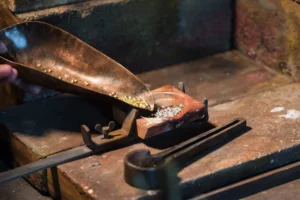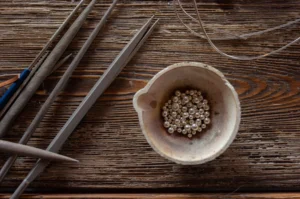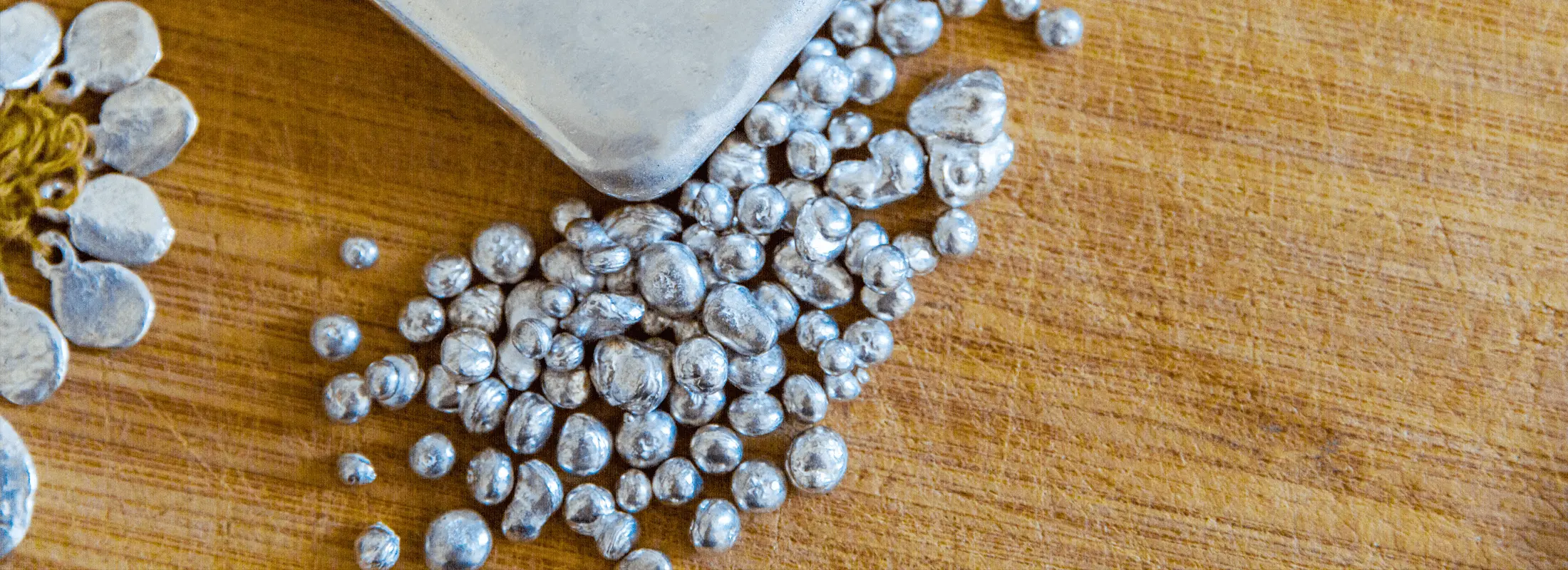Casting grain is the foundation of jewelry making. These small, irregularly-shaped granules of raw metals are the building blocks for countless creations crafted by jewelers and metalsmiths globally. According to the National Jewelers Association, over 75% of jewelry around the world is produced using casting grain! So, if jewelry comes from casting grain, where does casting grain come from?
How is Casting Grain Made?
Simply put, casting grain is created by melting metal and pouring it into water. Let’s take gold for example. To make gold casting grain, first the gold is refined to reach its desired purity level – often up to 99.9%. Pure gold is then melted and sometimes alloyed with other metals such as silver, copper, or nickel.
Once the desired color and purity is achieved and the molten metal is nice and homogenized, the metal is poured into a vessel of water through a sieve or perforated container. Once the molten gold or alloy drops into the water, it quickly cools and solidifies into little pellet-like grains. The grains continue cooling in the water and are eventually removed and dried.
Different Types of Casting Grain
While silver and gold casting grain are among the most popular, granules can be made out of many different types of metal – platinum, palladium, and even base metals like copper, brass and bronze.

Jewelers use a range of custom alloys, such as white and rose gold, while specialized alloys are crafted for various industrial applications. These alloys are tailored to achieve specific casting properties, including melting temperature, strength, and workability.
Silver casting grain is a popular choice for beginners, as it’s affordable and easier to work with due to its lower melting point and high malleability. Gold casting grain, while slightly more challenging to work with, offers unmatched resistance to tarnishing.
The Science of Casting
Using high-quality casting grain can make all the difference when casting jewelry. Grain shape is important and can actually influence the metal’s melting characteristics. Irregularly shaped grains tend to melt more uniformly, which is key in reducing the chance of porosity in the final product.
Casting jewelry is both an art and a science, requiring precise temperature control and an understanding of the melting points of different metals. For example, silver’s slower cooling rate enhances its workability, allowing more time to craft intricate designs.
Making Casting Grain From Scrap Metal
Recycled metals have long been used to make casting grain. Sourcing recycled metals is common throughout the jewelry and manufacturing industries, thanks to its environmental, social and economic benefits. (As a precious metals refiner, the Garfield team is especially familiar with these benefits!)
Sources of precious metal scrap include old or damaged jewelry, dental materials, electronic components and industrial by-products. Since precious metals must be refined and purified before being turned into casting grain, using refined scrap metal for this process is a practical and efficient choice.

A Sustainable Choice
With an increasing focus on sustainability, more and more jewelers are opting for recycled metals. These materials offer the same high quality as newly mined metals, but with a much smaller environmental impact. A report from the Responsible Jewellery Council indicates that using recycled metals in jewelry production could decrease the industry’s carbon footprint by as much as 60%!
And it’s not just eco-conscious jewelry makers that are driving the change – consumer demand for recycled jewelry has also gone up. A 2024 market analysis from the Global Jewelry Confederation reported a 40% increase in consumer preference for eco-friendly jewelry in the past 2 years.
In addition to enhancing environmental benefits, recycled metals help address concerns about conflict minerals and unethical mining practices. By opting for recycled metals, companies can pursue more responsible and ethical sourcing.
Where to Buy Casting Grain
Casting grain can be purchased online from a variety of retailers, including Garfield. Along with our variety of bullion products, we sell 24k gold casting grain, along with 18k, 14k and 10k options. We also offer white gold casting grain in both 14k and 18k varieties.
You can purchase bullion or casting grain directly from Garfield, or refine your precious metals and exchange their value for an equivalent amount of casting grain. If you’re a jeweler, this is a super convenient way to recycle materials. Even if you’re not in the market for more casting grain, refining your precious metal scrap is an excellent way to boost your business, providing extra revenue that can be used to upgrade equipment or offset operational costs. All in all, refining is a win-win!
If you’re looking to cash in on your precious metal scrap, look no further than Garfield Refining. With over 132 years of experience, we take pride in offering the industry’s best service and highest payouts. Learn more about our process or download a free label to start your shipment today!

